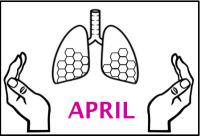
- Vasculitis
- Trials closed
APRIL
AbatacePt in Rheumatoid Arthritis-ILD
Research summary
Rheumatoid arthritis is a multi-system, autoimmune disease characterised by progressive inflammation and destruction of synovial joints and extra-articular structures. In recent decades, the natural history of rheumatoid arthritis (RA) has altered dramatically following a change in the treatment paradigm. The shift towards early, aggressive intervention with conventional disease-modifying drugs and the introduction of biologic agents into routine practice has substantially reduced the morbidity and premature mortality associated with RA secondary to effective abrogation of inflammation.
Lung disease in RA however remains an ongoing therapeutic challenge. The prevalence of clinically significant interstitial lung disease (ILD) in RA is up to 10% and is strongly associated with the presence of Anti-Citrullinated Protein Antibodies (ACPA). Patients with RA-ILD have an increased mortality compared to RA patients without ILD1. Median survival ranges between 3 and 8 years from time of diagnosis with RA-ILD.
The two most common forms of ILD are usual interstitial pneumonia (UIP) and non-specific interstitial pneumonia (NSIP), categorised by features on Computed Tomography scanning (CT) and histopathological evaluation. UIP is characterised on CT by the basal and sub-pleural predominance of reticular opacities, lung architectural distortion, traction bronchiectasis and honeycombing. NSIP demonstrates a uniform pattern of patchy ground glass, linear or reticular opacities but without honeycombing. UIP pattern RA-ILD is associated with a worse prognosis and increased mortality relative to NSIP, but is the most common subtype found in this group of patients.
The mechanism of RA-associated ILD is poorly understood. Epidemiological data demonstrates a strong association with smoking, high circulating levels of rheumatoid factor and the presence of ACPA. ACPA-positive lung disease can occur in the absence of joint disease, and citrullinated proteins have been found in the lungs and bronchoalveolar lavage (BAL) fluid of RA-ILD patients. Citrullination itself may be a trigger for immune dysregulation, and inflammatory markers IFN-y and TGF-ß2 were higher in BAL derived from patients with early RA and sub-clinical ILD that demonstrated radiographic progression. However, there is a limited evidence base on the relationship between biologic agents and RA-ILD. To date, there have been no trials specifically evaluating the impact of biological therapies on RA-ILD and the number of ILD exacerbations on such treatment is low in the general RA population.
The treatment of RA-ILD represents a management dilemma. Given that the therapeutic goal for RA is remission, clinicians increasingly face the challenge of choosing the optimal biologic agent in patients with RA-ILD and uncontrolled joint disease. There are no evidence-based guidelines to guide physicians in deciding whether to commence biologic therapy in this setting, or in selecting which drug is most appropriate. For patients whose joint disease is inadequately controlled with traditional non-biologic Disease-Modifying anti-rheumatic drugs (DMARDs), the choice of biologic DMARD is fraught with the risk of exacerbating their lung disease.
The purpose of this trial is to evaluate the impact of abatacept on RA-ILD, predominantly focusing on drug safety. A pilot study was developed to help inform this clinical question. An interventional trial was deemed to be necessary as the numbers of RA patients who have ILD and active joint disease that would qualify for abatacept treatment as routine standard of care would be too low to make an observational study feasible. Additionally, an interventional trial is advantageous in allowing standardized monitoring of the parameters of interest. Furthermore, as there is no standard of care in the management of RA-ILD, a head-to-head trial with an active comparator is not possible.
Main inclusion criteria
To be included in the trial the participant must:
- Be aged 18 years or over (for participants aged 65 and over, additional caution should be taken to assess their health status prior to inclusion)
- Agree to use 2 forms of effective contraception for the duration of the trial and a further 14 weeks after completion (see section 11.7)
- Meet a diagnosis of RA by 2010 EULAR/ACR criteria
- Have interstitial lung disease associated with RA, with supportive findings on their PFTs and CT Chest scans. Participants will be included if their ILD has progressed over 14 months. Progression will be defined as EITHER:
- A decrease in FVC by at least 5% when comparing two sets of PFTs done in the last 24 months, but with an interval of up to 14 months between the PFTs
OR - Progression of lung fibrosis on a high-resolution CT chest, as reported by a chest radiologist.
- A decrease in FVC by at least 5% when comparing two sets of PFTs done in the last 24 months, but with an interval of up to 14 months between the PFTs
Main exclusion criteria
The presence of any of the following will preclude patient participant inclusion:
- Unable to provide informed written consent
- Participants who are taking other immunosuppressants, e.g. mycophenolate mofetil (MMF), unless this has been discontinued with an adequate washout period. The exceptions to this exclusion criterion are methotrexate (MTX) and hydroxychloroquine, which are allowed provided the dose has been stable for 6 weeks prior to baseline (visit 2).
- Participants who have been taking ≥ 10mg Prednisolone daily within the last 6 weeks prior to baseline (visit 2)
- Participants who have had rituximab, within the 24 weeks prior to baseline (Visit 2)
- Any participant with active signs or symptoms of infection at the time of recruitment baseline (visit 2) or requiring antibiotic treatment within the preceding 4 weeks
- Any participant with significant co-existing lung disease, such as asthma, bronchiectasis, emphysema, Chronic Obstructive Pulmonary Disease (COPD) or if their pre-bronchodilator FEV1/FVC ratio is < 70%.
- Significant other co-morbidity (e.g. active malignancy/liver disease/renal disease) within the last 5 years
- Prior use of abatacept at any time
- Participation in any other clinical trial within 8 weeks prior to baseline visit (Visit 2) (Participation on 'observational' studies is allowed)
- Hypersensitivity to any excipients of abatacept
- Any participant who has had live vaccines within 6 weeks prior to baseline (Visit 2)
- Participant is pregnant or breastfeeding
Funders and sponsors
Funders: Bristol Myers Squibb
Sponsors: Cambridge University Hospitals NHS Foundation Trust and University of Cambridge
Chief investigator
Dr Frances Hall






